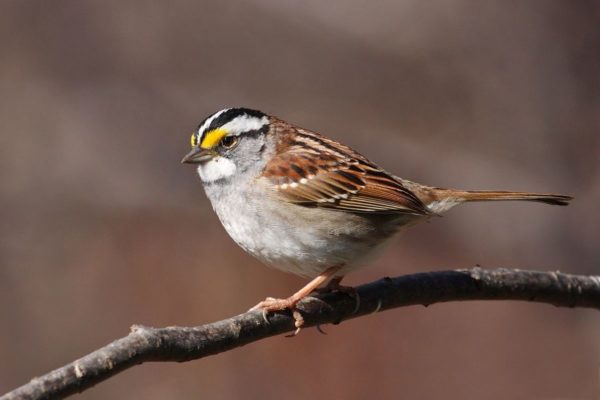Information About The Bird
Seen/Heard at
Decorah, Decorah North. We see and hear White-throated Sparrows as they migrate through the Decorah area. White-throated sparrows winter just south of the Decorah area, returning to nest in northern forests in the US and Canada between mid-April and mid-May.
Diet
White-throated Sparrows are ground foragers. During the winter, White-throated Sparrows eat seeds and dried fruit, including ragweed, buckwheat, hemp, sumac, grape, cranberry, mountain ash, rose, blueberry, blackberry, and dogwood. People just south of Decorah might also see them eating millet and black oil sunflower seeds at birdfeeders during the winter. In spring, White-throated Sparrows eat the buds, blossoms, and young seeds of oak, apple, maple, beech, and elm as they work their way north.
Nesting
White-throated Sparrows breed from mid-May through early August. They nest on or slightly above the ground, usually under shrubs, grasses, ferns, or dead vegetation from the previous year. Female White-throated Sparrows build their well-concealed, open-cup nests from moss, grass, twigs, weeds, and pine needles and line them with fine grass, rootlets, and animal hair. After building a nest, they lay one to six tan eggs speckled with brown per clutch, producing up to two broods per year. Females incubate eggs for 11-14 days and young leave the nest seven to 12 days after hatching. Both parents care for young once the eggs have hatched. To learn more, visit Cornell’s website.
White-throated Sparrows are sometimes described as having four sexes. You can read more about that here: https://www.audubon.org/news/the-fascinating-and-complicated-sex-lives-white-throated-sparrows.
Citations
Bird Range Maps of North America
Ridgely, R.S., T.F. Allnutt, T. Brooks, D.K. McNicol, D.W. Mehlman, B.E. Young, and J.R. Zook. 2003.
Digital Distribution Maps of the Birds of the Western Hemisphere, version 1.0. NatureServe, Arlington, Virginia, USA. Data provided by NatureServe in collaboration with Robert Ridgely, James Zook, The Nature Conservancy – Migratory Bird Program, Conservation International – CABS, World Wildlife Fund – US, and Environment Canada – WILDSPACE.
Web Link: http://bit.ly/2ynPQ5I
The Cornell Lab of Ornithology Birds of North America: https://birdsna.org/Species-Account/bna/species/whtspa/breeding
All About Birds: https://www.allaboutbirds.org/guide/White-throated_Sparrow/lifehistory
General Description
White-throated Sparrows have two distinct color morphs. The white-striped color morph has a boldly striped black and white head, a bright white throat, and a vivid yellow spot between its eye and its gray beak. It is brown above with a grey bib that fades to light grey underparts. The tan-striped color morph is less colorful, with a buff-on-brown face pattern.
Migration
White-throated sparrows winter just south of the Decorah area, returning to nest in northern forests in the US and Canada between mid-April and mid-May. We see them as they migrate through the Decorah area.
Measurements
Length: 6.3-7.1 in/16-18 cm
Wingspan: 7.9-9.1 in/20-23 cm
Weight: 0.8-1.1 oz/22-32 g
Wing Design
Elliptical. Optimized for bursts of fast, tightly controlled flight. Excellent at taking off quickly, maneuvering through branches, and avoiding predators.
| See also different: | Decorah Nest, Sparrows and Towhees |
